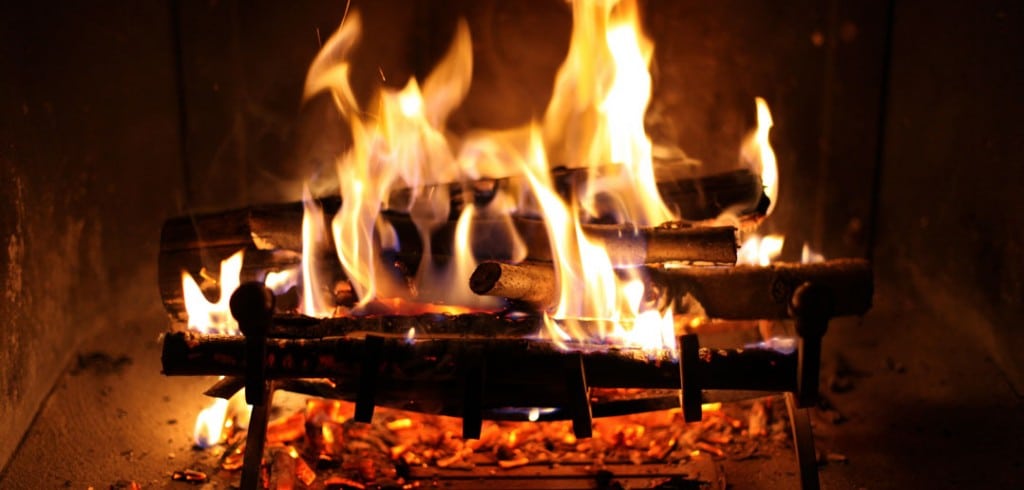Dear Jim: We like to use our open wood-burning fireplace, but it makes the rest of the house cold. Our heating bills are high enough, so what simple things can we do to make the fireplace more efficient? — Jan W.
During the winter, a warm fire can be quite comfortable. Radiant heat from the flames and coals keeps you warm when you are sitting directly in front of an open fireplace. Unfortunately, most fireplaces lose more heat than they produce.
That warm, relaxing open fire is actually costing you a lot of money — in several ways. First, for some, firewood must be purchased, which is not cheap. Second, the radiant heat feels nice in front of the fire, but already-heated air is being sucked up the chimney from the rest of your house, making your heat pump or furnace run longer. Third, if there is no damper on the fireplace or the fireplace is not fitted with its own outdoor air source, indoor air is escaping up the chimney when the fireplace is not in use. Adding a source of combustion air that ducts into the fireplace can help a great deal: The fire draws the air it needs for proper combustion and draft from outside rather than conditioned air from inside.
The best tip is to avoid using the fireplace in extremely cold weather. All of the indoor air lost up the chimney is being drawn outdoors through leaks in the house exterior. During milder weather, because the air leaking indoors is not as cold, less energy is needed to warm up this cold air.
It also helps to crack open a window at little in the room by the fireplace and close doors leading to the room. Much of the excess air being drawn up the chimney will be cold outdoor air from the open window. When sitting right in front of the hot fire, you probably will not notice the chilly breeze.
Do not place wood into the fire several hours before bedtime to ensure the fire is totally out by the time you go to sleep. It is not safe to leave a smoldering fire. Also, if the fire is completely out, you can close the chimney damper to block room air loss without filling the room with smoke.
If you make just one investment to improve the efficiency of your fireplace, it should be to install high-quality glass doors. These doors control the amount of indoor air that escapes up the chimney when a fire is burning and also when one is not.
High-quality fireplace doors are not cheap, but they are worth the expense. The best doors are relatively airtight when closed. By adjusting combustion air vents in the bottom of the glass door frame, you can still have a raging fire without major indoor air loss.
Keep in mind that the fire does need an adequate supply of combustion air for an efficient, clean burn. If the airflow is reduced too much, creosote buildup occurs, leaving the potential for a chimney fire. I recommend having the chimney inspected and regularly using several squirts of a creosote control spray during each fire.
Burn only well-seasoned wood or no more than one unseasoned log to three seasoned ones. If you try to burn more unseasoned wood, it requires more combustion air to keep it burning well, which draws even more air out of your home.
There are several types of heat-circulating grates that increase the heat output from a fireplace. Select a model with a blower that has several speeds and a thermostat with an on/off switch. This switch shuts off the blower when the fire burns down. If you prefer to use the fireplace with the doors open, tubular heat-circulating grates are available to blow the heat directly out the front. Other models have no blower and rely on natural convection.
Stoll Fireplaces makes a unique heat exchanger that mounts at the top of the fireplace opening, creating a tremendous amount of heat output. These models work with gas or wood-burning fireplaces.
When your fireplace is not in use, insert an inflatable chimney pillow in the fireplace flue. This seals much better than the chimney damper. Chimney-top dampers, operated from indoors using a chain, also help reduce air leakage and keep critters and debris out of the chimney. Hang a sign or ribbon in the fireplace to indicate that the damper is shut or a pillow is installed to stop someone from building a fire when the chimney is closed.
For additional information about fireplace efficiency, check out TogetherWeSave.com’s Home Efficiency Analysis Tool (homeefficiency.togetherwesave.com).
These companies offer fireplace efficiency products: Battic Door, 508-320-9082, www.batticdoor.com; Diamond W. Products, 248-652-8833, www.diamond-w.com; Northline Express, 866-667-8454, www.northlineexpress.com; SaverSystems, 800-860-6327, www.homesafetyproducts.biz; and Stoll Fireplace Inc., 800-421-0771, www.stollfireplaceinc.com.
Flickr image by Matteo Paciotti.



